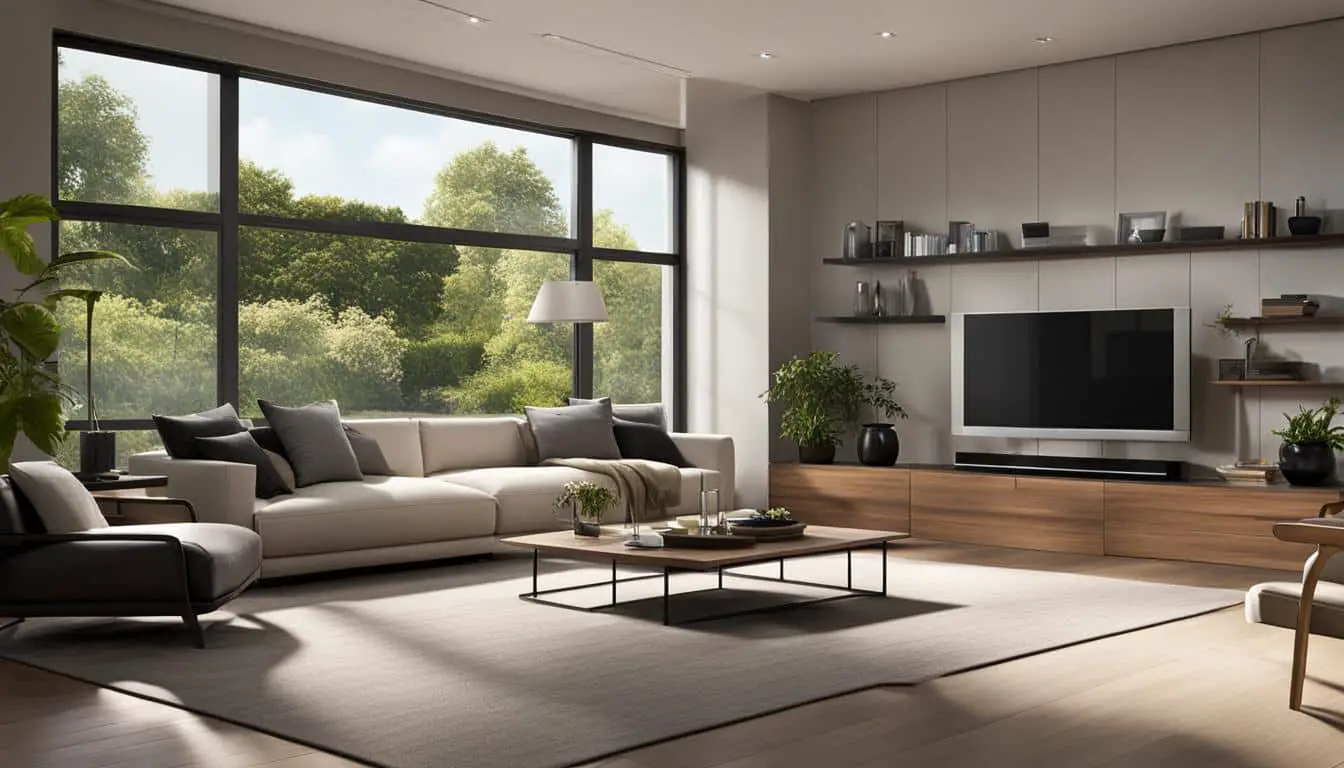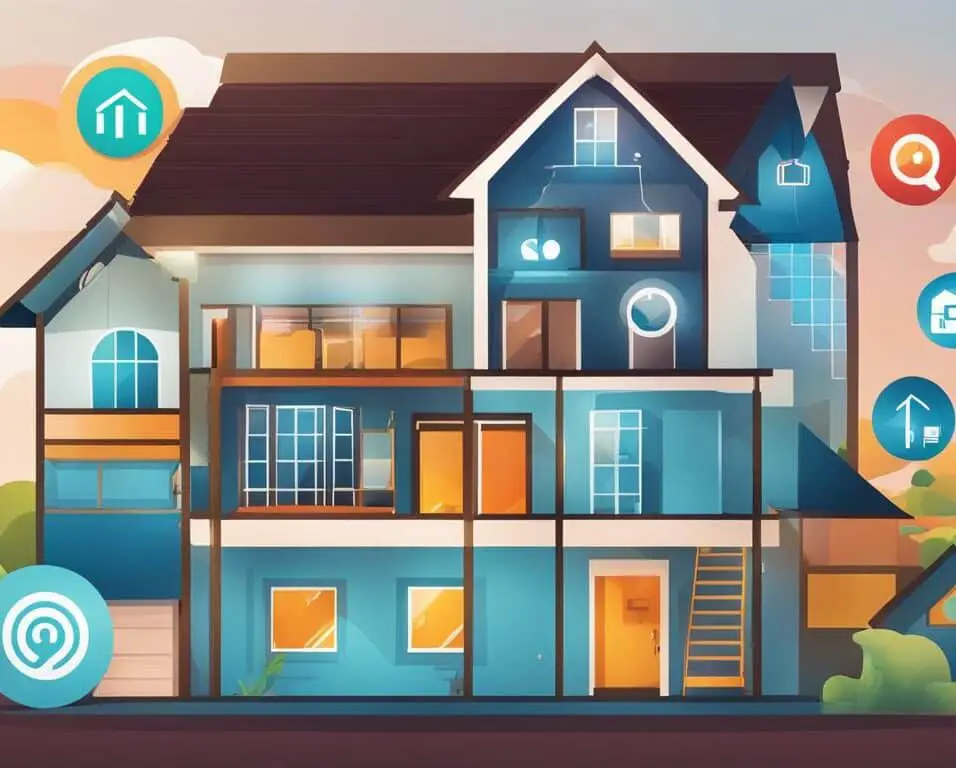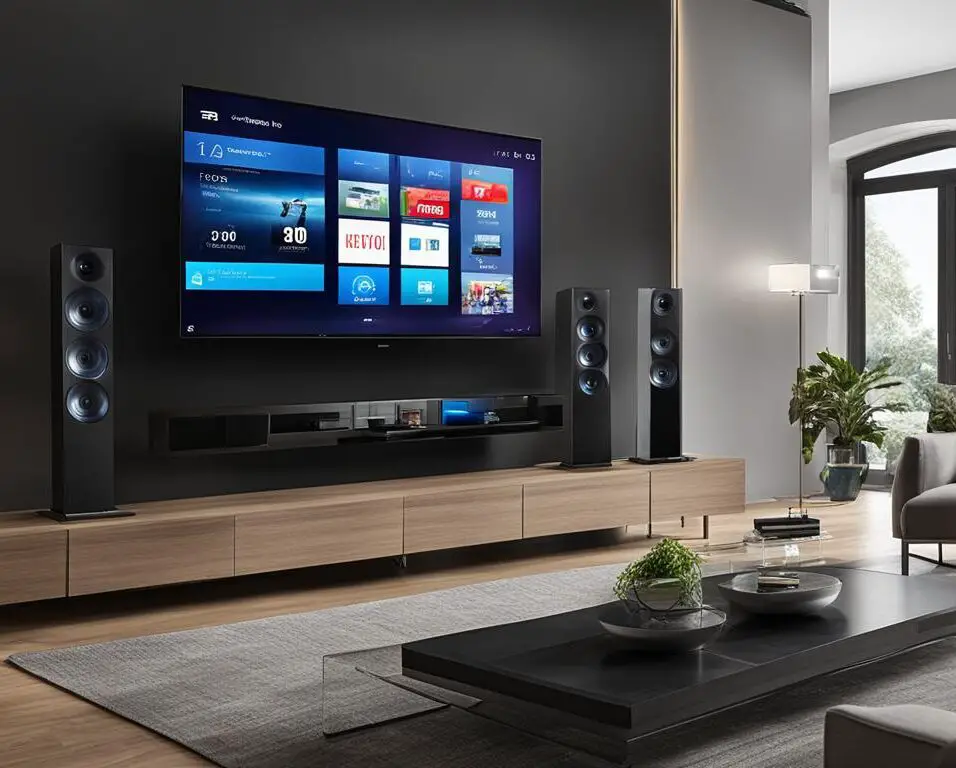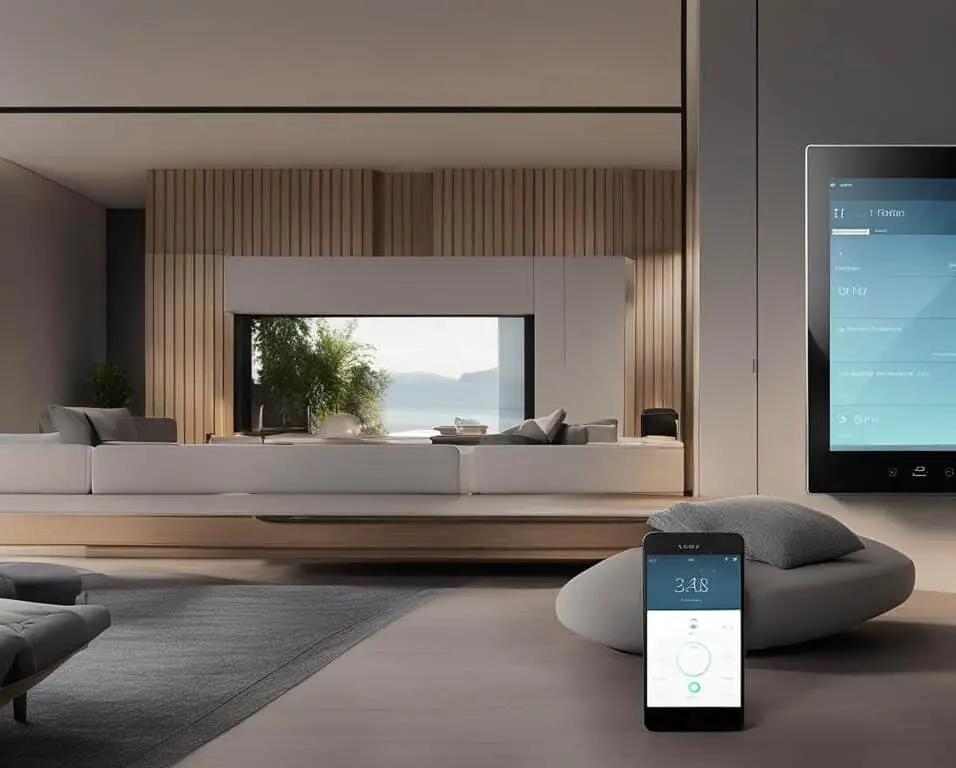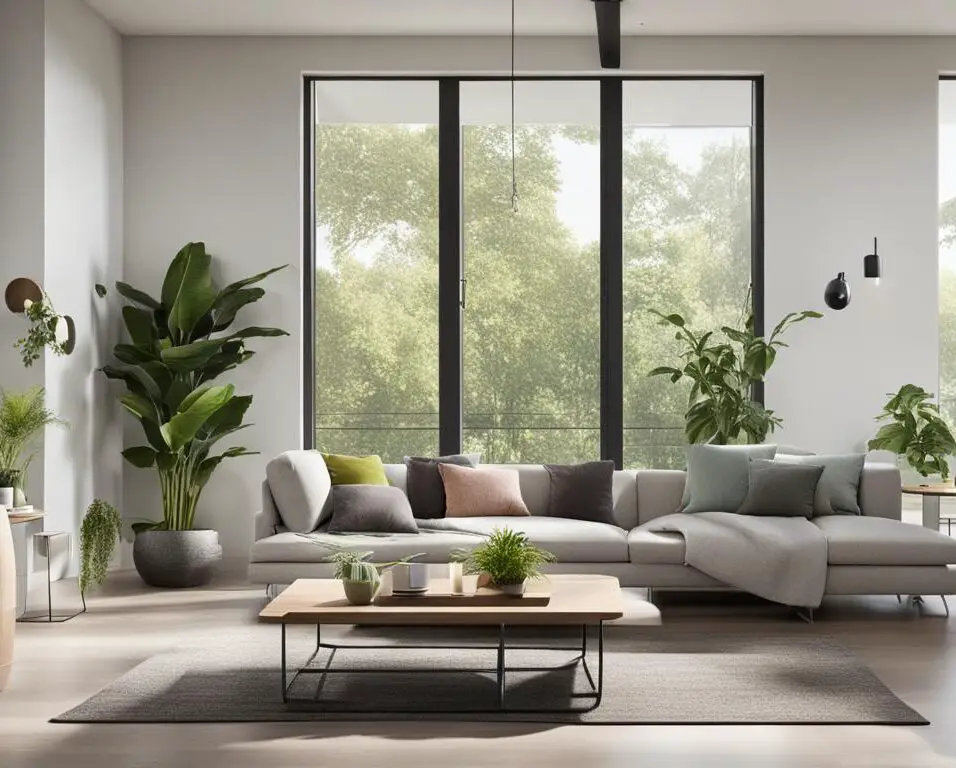Smart Windows and Blinds: Revolutionizing Home Comfort
Welcome to the world of smart windows and blinds technology, where automated window coverings are transforming the way we experience home comfort. With the rise of motorized blinds and energy-efficient windows, homeowners can now enjoy convenience, energy savings, and enhanced security like never before.
Imagine being able to control the position of your blinds with a simple swipe on your smartphone app or a voice command to your virtual assistant like Amazon Alexa or Google Assistant. Smart blinds offer this level of automation, giving you the power to optimize natural light entry and regulate indoor temperatures effortlessly.
But the benefits extend beyond convenience. By optimizing natural light and regulating indoor temperatures, smart blinds contribute to energy efficiency, resulting in lower energy bills and a reduced environmental impact. They also enhance home security by simulating daily routines and creating the illusion of an occupied home when you’re away.
What’s more, integrating smart blinds with other smart home devices creates a cohesive and synchronized smart home experience. From setting preferences for different times of the day to creating personalized ambiance, smart blinds offer a new level of customization in your home.
Key Takeaways:
- Smart windows and blinds technology revolutionizes home comfort through automation and convenience.
- Automated window coverings contribute to energy efficiency and lower energy bills.
- Smart blinds enhance home security by simulating occupancy.
- Integration with other smart home devices creates a cohesive smart home experience.
- Smart blinds allow for personalized ambiance creation and customization in the home.
The Rise of Smart Home Improvements for Cooling
Smart home automation has revolutionized the way we control and enhance our living spaces. When it comes to cooling our homes, smart technologies offer innovative solutions that prioritize energy efficiency and comfort. From window shades to remote control blinds, voice-controlled window treatments, and connected window solutions, there are numerous options to choose from.
A cornerstone of smart home cooling is the implementation of smart thermostats. These devices learn our habits and adjust the temperature accordingly, ensuring precise climate control. But it doesn’t stop there – automated blinds and curtains can be programmed to open and close based on the sun’s position and outdoor temperature. By maximizing their impact on regulating indoor temperatures, these smart window coverings contribute significantly to energy optimization.
To enhance air circulation, smart fans are an excellent addition to any smart home cooling system. These fans can adjust their speed based on temperature and humidity levels, ensuring optimal comfort while conserving energy. What’s more, these fans can be conveniently voice-controlled, allowing for seamless integration into your smart home ecosystem.
When considering smart home improvements for cooling, it’s important to take various factors into account. Compatibility with existing smart home devices, user-friendly interfaces, remote access and control, learning capabilities, and integration with virtual assistants like Amazon Alexa or Google Assistant should all be considered. By choosing the right connected window solutions and smart technologies, you can create a comfortable, energy-efficient home that aligns with your unique needs and preferences.
| Smart Home Improvements for Cooling | Key Features |
|---|---|
| Smart Thermostats | – Learning capabilities |
| – Precise climate control | |
| – Energy optimization | |
| Automated Blinds and Curtains | – Programmable opening and closing |
| – Energy-efficient temperature regulation | |
| Smart Fans | – Adjustable speed based on temperature and humidity |
| – Voice-controlled convenience |
Understanding Smart Windows and their Benefits
Smart windows, powered by innovative smart glass technology, are revolutionizing the way we experience and interact with our living spaces. These advanced window solutions offer a myriad of benefits, ranging from energy efficiency to personalized comfort.
There are different types of smart windows available, including electrochromic, photochromic, thermochromic, and liquid crystal. Each type operates uniquely, providing specific advantages for homeowners. Electrochromic windows, for instance, allow for precise control over light levels by adjusting tint with low electricity voltage. On the other hand, photochromic windows automatically adapt their tint based on sunlight intensity, optimizing energy consumption and ensuring a comfortable indoor environment.
One of the notable benefits of smart windows is their ability to enhance energy efficiency. By regulating natural light entry and optimizing temperature control, these windows contribute to lower energy consumption and reduced environmental impact. Furthermore, smart windows offer privacy on demand, with liquid crystal windows providing an instant switch from transparent to opaque, ensuring a sense of security and exclusivity.
Smart windows also integrate seamlessly into connected window solutions, allowing homeowners to control and customize their window settings through smartphone apps or virtual assistants. This synergy between smart windows, window shades, and other connected devices creates a cohesive smart home ecosystem, enhancing convenience and comfort.
FAQ
What are smart blinds?
Smart blinds are window coverings that offer convenience and automation. They can be controlled using a smartphone app or virtual assistants like Amazon Alexa or Google Assistant.
How do smart blinds contribute to energy efficiency?
Smart blinds optimize natural light entry and regulate indoor temperatures, resulting in lower energy bills and reduced environmental impact.
How do smart blinds enhance home security?
Smart blinds simulate daily routines and create the illusion of an occupied home, enhancing home security when users are away.
How do smart blinds integrate with other smart home devices?
Smart blinds can be integrated with other smart home devices, creating a cohesive and synchronized smart home experience.
Can smart blinds create personalized ambiance in the home?
Yes, smart blinds allow users to set preferences for different times of the day, allowing for personalized ambiance creation in the home.
What are smart thermostats?
Smart thermostats are devices that learn habits and adjust temperature accordingly for precise climate control in a smart home.
How can automated blinds and curtains help regulate indoor temperatures?
Automated blinds and curtains can be programmed to open and close based on the sun’s position and outdoor temperature, maximizing their impact on regulating indoor temperatures.
How do smart fans enhance air circulation?
Smart fans adjust their speed based on temperature and humidity levels, enhancing air circulation. They can also be voice-controlled for added convenience.
What is the priority of smart home improvements for cooling?
Smart home improvements for cooling prioritize energy optimization, resulting in lower energy consumption and reduced environmental impact.
What factors should be considered when choosing smart home improvements?
When choosing smart home improvements, factors such as compatibility, user-friendly interfaces, remote access and control, learning capabilities, and integration with virtual assistants should be considered.
What are smart windows?
Smart windows are glass panes that can change their light transmission properties, providing convenience, efficiency, and comfort in modern living spaces.
What are the different types of smart windows?
There are different types of smart windows, including electrochromic, photochromic, thermochromic, and liquid crystal, each with unique characteristics and ways of operation.
How do electrochromic windows work?
Electrochromic windows use low electricity voltage to adjust tint, providing precise control over light levels.
How do photochromic windows work?
Photochromic windows respond to UV light and automatically adjust their tint based on the intensity of sunlight, offering energy-efficient comfort.
How do thermochromic windows work?
Thermochromic windows change tint based on temperature, optimizing energy conservation and climate control.
How do liquid crystal windows work?
Liquid crystal windows can switch from transparent to opaque at the flick of a switch, offering instant privacy.
What are the benefits of smart windows?
Smart windows provide benefits such as energy efficiency, comfort and convenience, privacy, UV protection, and integration with smart home ecosystems.
How do smart windows contribute to sustainable living?
Smart windows reduce energy consumption and align with green building standards, contributing to sustainable living.
What are the long-term benefits of smart windows?
While smart windows require an upfront investment, they offer long-term financial and energy savings, as well as customization and personalization options.
How is the smart window industry advancing?
The smart window industry is continuously advancing, with ongoing research and development in areas such as solar energy and security integration.
What do smart windows represent?
Smart windows represent a shift in how we interact with living spaces, combining comfort, innovation, and sustainability.



